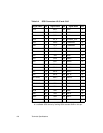
B-6 Glossary Terms and Abbreviations
SCSI ID A way to uniquely identify each SCSI device on the SCSI bus. Each SCSI
bus has eight available SCSI IDs numbered 0 through 7 (or 0 through
15 for Wide SCSI). The host adapter usually gets the highest ID (7 or 15)
giving it priority to control the bus.
SDMS Storage Device Management System. An LSI Logic software product that
manages SCSI system I/O.
Single-Ended
SCSI
A hardware specification for connecting SCSI devices. It references each
SCSI signal to a common ground. This is the most common method (as
opposed to differential SCSI which uses a separate ground for each
signal).
STA SCSI Trade Association. A group of companies that cooperate to
promote SCSI parallel interface technology as a viable mainstream I/O
interconnect for commercial computing.
Synchronous
Data Transfer
One of the ways data is transferred over the SCSI bus. Transfers are
clocked with fixed-frequency pulses. This is faster than asynchronous
data transfer. Synchronous data transfers are negotiated between the
SCSI host adapter and each SCSI device.
System BIOS Controls the low level POST (Power-On Self-Test), and basic operation
of the CPU and computer system.
Ultra SCSI A standard for SCSI data transfers. It allows a transfer rate of up to
20 Mbytes/s over a 8-bit SCSI bus and up to 40 Mbytes/s over a 16-bit
SCSI bus. STA (SCSI Trade Association) supports using the term “Ultra
SCSI” over the term “Fast-20”.
Ultra2 SCSI A standard for SCSI data transfers. It allows a transfer rate of up to
40 Mbytes/s over an 8-bit SCSI bus, and up to 80 Mbytes/s over a
16-bit SCSI bus. STA (SCSI Trade Association) supports using the term
“Ultra2 SCSI” over the term “Fast-40”.
VCCI Voluntary Control Council for Interference.
VDE Verband Deucher Elektroniker (Association of German Electrical
Engineers).
Virtual Memory Space on a hard disk that can be used as if it were RAM.


















